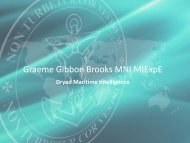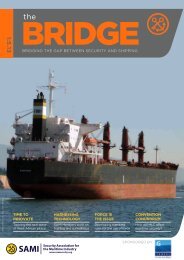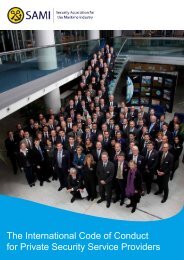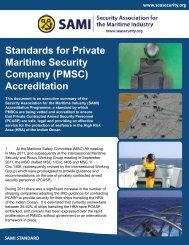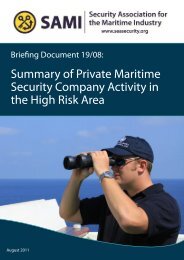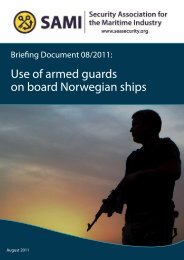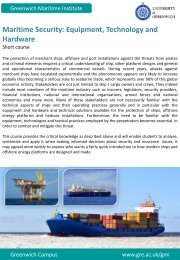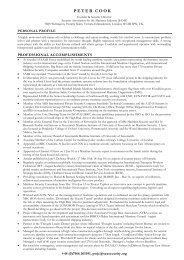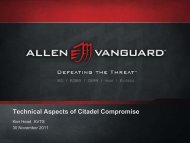SAMI Briefing Maritime Labour Convention FAQs and Text March 2013
SAMI Briefing Maritime Labour Convention FAQs and Text March 2013
SAMI Briefing Maritime Labour Convention FAQs and Text March 2013
Create successful ePaper yourself
Turn your PDF publications into a flip-book with our unique Google optimized e-Paper software.
obligations. They are followed by the more detailed Regulations <strong>and</strong> Code (with two parts:Parts A <strong>and</strong> B) provisions. The Regulations <strong>and</strong> the St<strong>and</strong>ards (Part A) <strong>and</strong> Guidelines(Part B) in the Code are set out in five Titles, which essentially cover the same subjectmatter [see A6. What are the subjects of the “Titles”?] as the existing 37 maritime labour<strong>Convention</strong>s <strong>and</strong> associated Recommendations, updating them where necessary. There area few new subjects, particularly in the area of occupational safety <strong>and</strong> health to meetcontemporary concerns, such as the effects of noise <strong>and</strong> vibration on workers or otherworkplace risks, but in general the <strong>Convention</strong> aims at maintaining the st<strong>and</strong>ards in thecurrent instruments at their present level, while leaving each country greater discretion inthe formulation of their national laws establishing that level of protection. The provisionsrelating to flag State inspection, including the use of “recognized organizations” buildsupon the existing ILO maritime labour inspection <strong>Convention</strong> (No. 178). The potential forinspections in foreign ports (port State control) in Title 5 is based on existing maritime<strong>Convention</strong>s, in particular <strong>Convention</strong> No. 147 – the Merchant Shipping (MinimumSt<strong>and</strong>ards) <strong>Convention</strong>, 1976 <strong>and</strong> the <strong>Convention</strong>s adopted by the International <strong>Maritime</strong>Organization (IMO) <strong>and</strong> the regional port State control agreements (PSC MOU). However,the MLC, 2006 builds upon them to develop a more effective approach to these importantissues, consistent with other international maritime <strong>Convention</strong>s that establish st<strong>and</strong>ardsfor quality shipping with respect to issues such as ship safety <strong>and</strong> security <strong>and</strong> protection ofthe marine environment. One of the most innovative aspects of the MLC, 2006, as far asILO <strong>Convention</strong>s are concerned, is the certification of seafarers’ living <strong>and</strong> workingconditions on board ships.A6. What are the subjects of the “Titles”?The Regulations of the MLC, 2006 <strong>and</strong> the St<strong>and</strong>ards (Part A) <strong>and</strong> Guidelines(Part B) in its Code are integrated <strong>and</strong> organized into general areas of concern underfive Titles:Title 1:Title 2:Title 3:Title 4:Title 5:Minimum requirements for seafarers to work on a shipConditions of employmentAccommodation, recreational facilities, food <strong>and</strong> cateringHealth protection, medical care, welfare <strong>and</strong> social security protectionCompliance <strong>and</strong> enforcementA7. Does the MLC, 2006 directly apply to shipowners, ships <strong>and</strong> seafarers?The MLC, 2006 is an international legal instrument <strong>and</strong> does not, therefore, applydirectly to shipowners, ships or seafarers. Instead like all international law, it relies onimplementation by countries through their national laws or other measures [see A.8 Whatmeasures must a country take to ensure that the MLC, 2006 is properly applied?]. Thenational law or other measures would then apply to shipowners, seafarers <strong>and</strong> ships. TheMLC, 2006 sets out the minimum st<strong>and</strong>ards that must be implemented by all countries thatratify it. These st<strong>and</strong>ards must be reflected in the national st<strong>and</strong>ards or requirements <strong>and</strong>are subject to the usual oversight role taken by the Committee of Experts under the ILOFAQ 5




